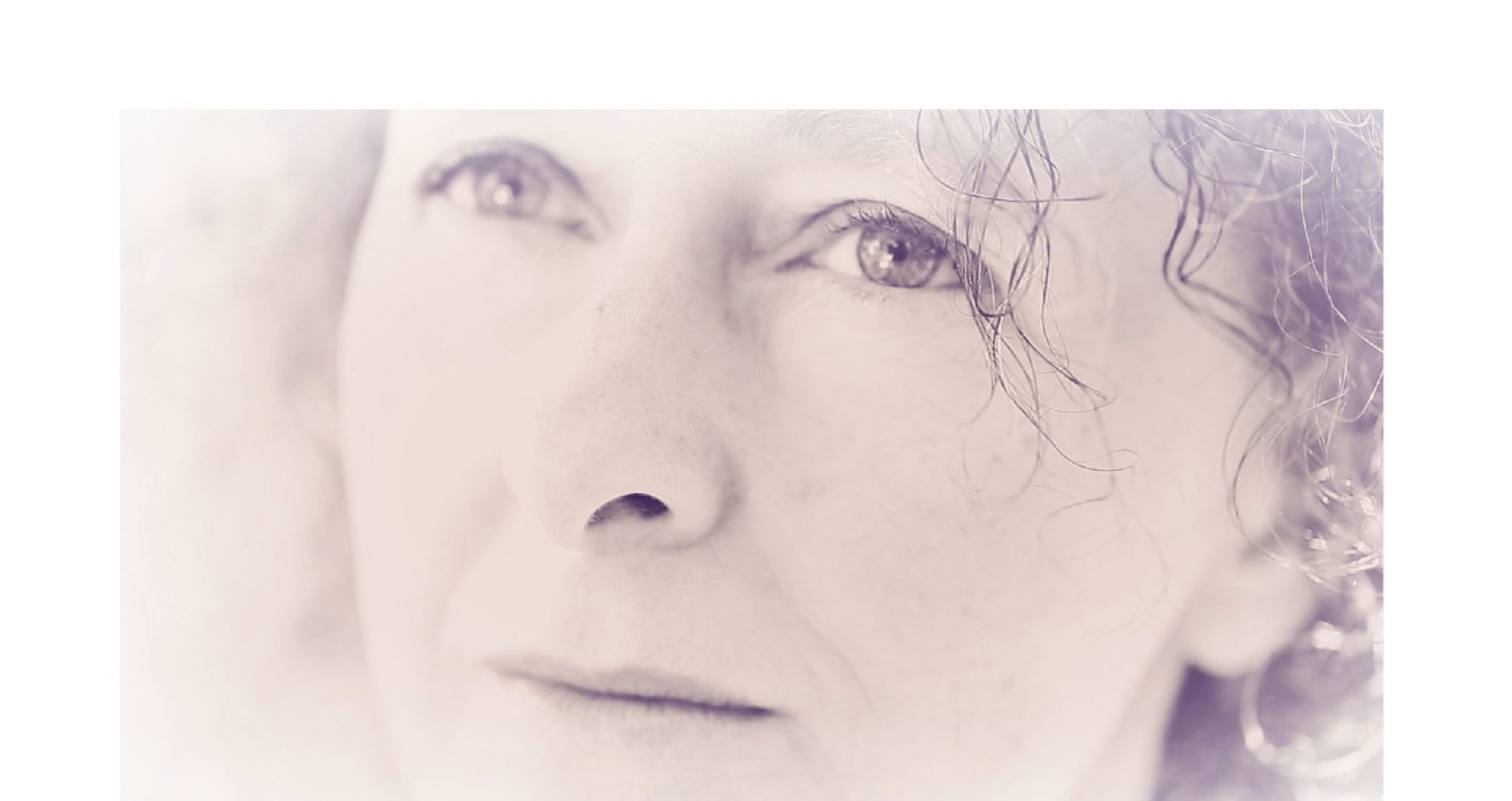
FILM-CONCERTS
LE ROI DU CIRQUE
Movie by Édouard-Émile Violet & Max Linder
Composition and keyboards : Pierre-Adrien Charpy | Voice : Raphaële Kennedy | Electric doublebass : Éric Chalan | Drums : Christian Bini
A co-production Da Pacem and Tous en sons! festival

Max de Pompadour is an inveterate party animal. Asked by his uncle to settle down and get married, he says he loves the beautiful Ketty, who is a triumph at the Buffalo Circus. Neither Max’s uncle nor Ketty’s father accepts what they see as a mismatch. At Ketty’s insistence, Max decides to become « king of the circus » : he dreams of becoming an acrobat, then a flea trainer, takes on an opponent in a boxing match and, believing he has faked a dressage act, turns up smiling in front of a ferocious lion. Will this be enough to win Ketty’s hand ? Long lost, this little gem of silent cinema released just over a century ago has been reconstructed and restored by Lobster Films from 11 fragments found around the world.
PÉLAGOS
Musical docu-fiction by Aurélien Charpy & Pierre-Adrien Charpy
Realisation and editing : Aurélien Charpy | Music : Pierre-Adrien Charpy | Percussion : Christian Bini & Cédric Clef | Underwater shots : Sandrine Ruitton
A Da Pacem production | Project supported by Fondation Stin ‘Akri | In partnership with Anthropie Productions and In Medias Res
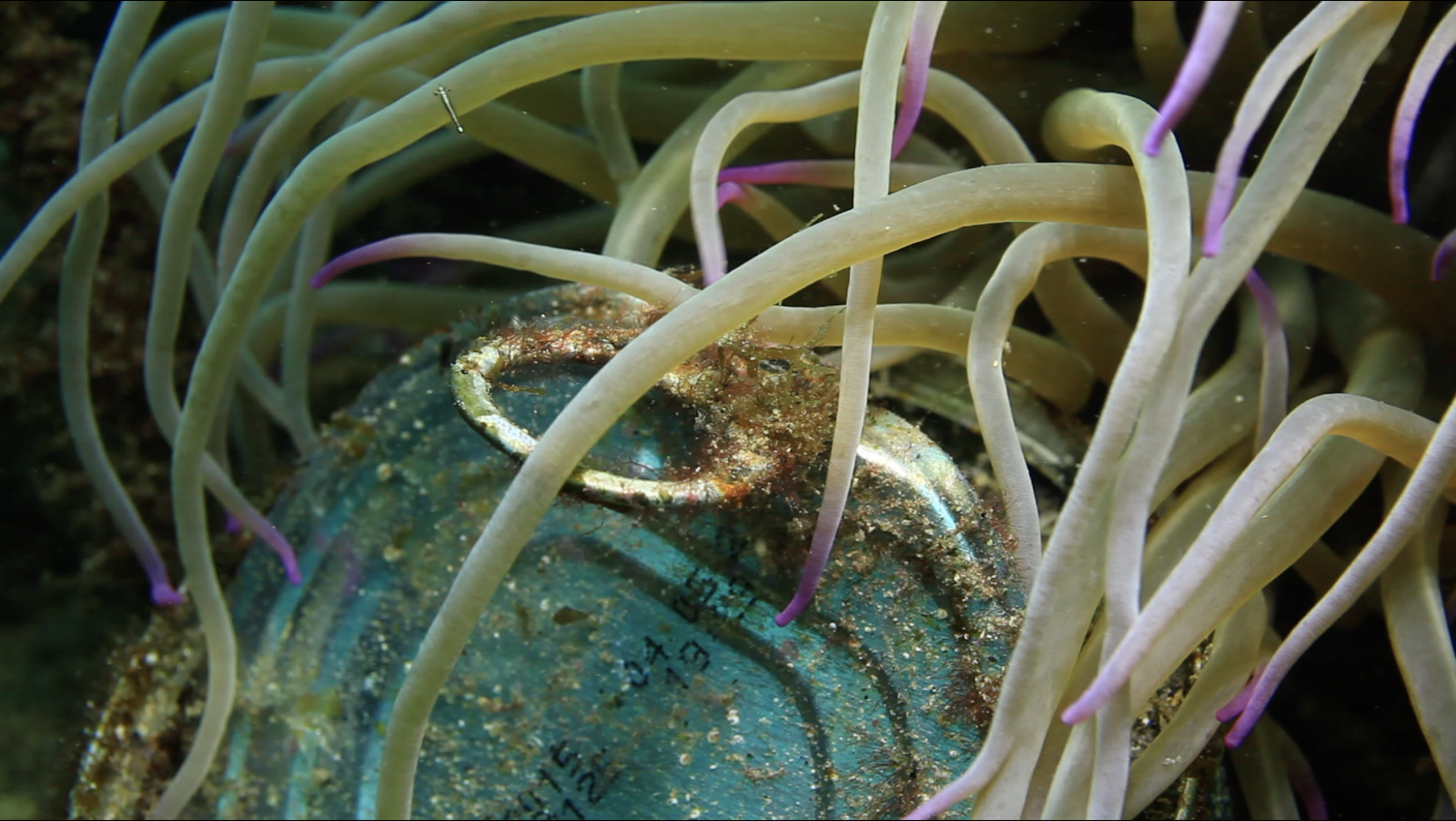
The ciné-concert Pélagos was born of the desire to combine the creation of two works, music and film, with the issue of marine ecology and more particularly the overproduction of waste by our modern societies. From the Greek Πέλαγος, the open sea, its name evokes the immensity of the oceans and raises the question of its extreme fragility in the face of the onslaught of pollution. The « open sea » has thus become a sea « full of waste » which must lead us to change our behaviour. The musical part of the piece uses an original instrumentarium made up of recycled waste (polystyrene, bottles, cans, metal parts, pvc, etc.) and an electroacoustic device to complement it. The cinematographic part of the film, produced in the form of a docu-fiction, combines archive footage (with images supplied by the CNRS) and filming in situ, taking the viewer on a dreamlike journey where the real collides with the imaginary. Pélagos aims to raise awareness and is part of an eco-citizen approach to educating people about consumption, waste and recycling.
L’ÎLE PARADIS QU’ON NE DOIT PAS DIRE
Musical and visual creation by Pierre-Adrien Charpy & Isabelle Françaix
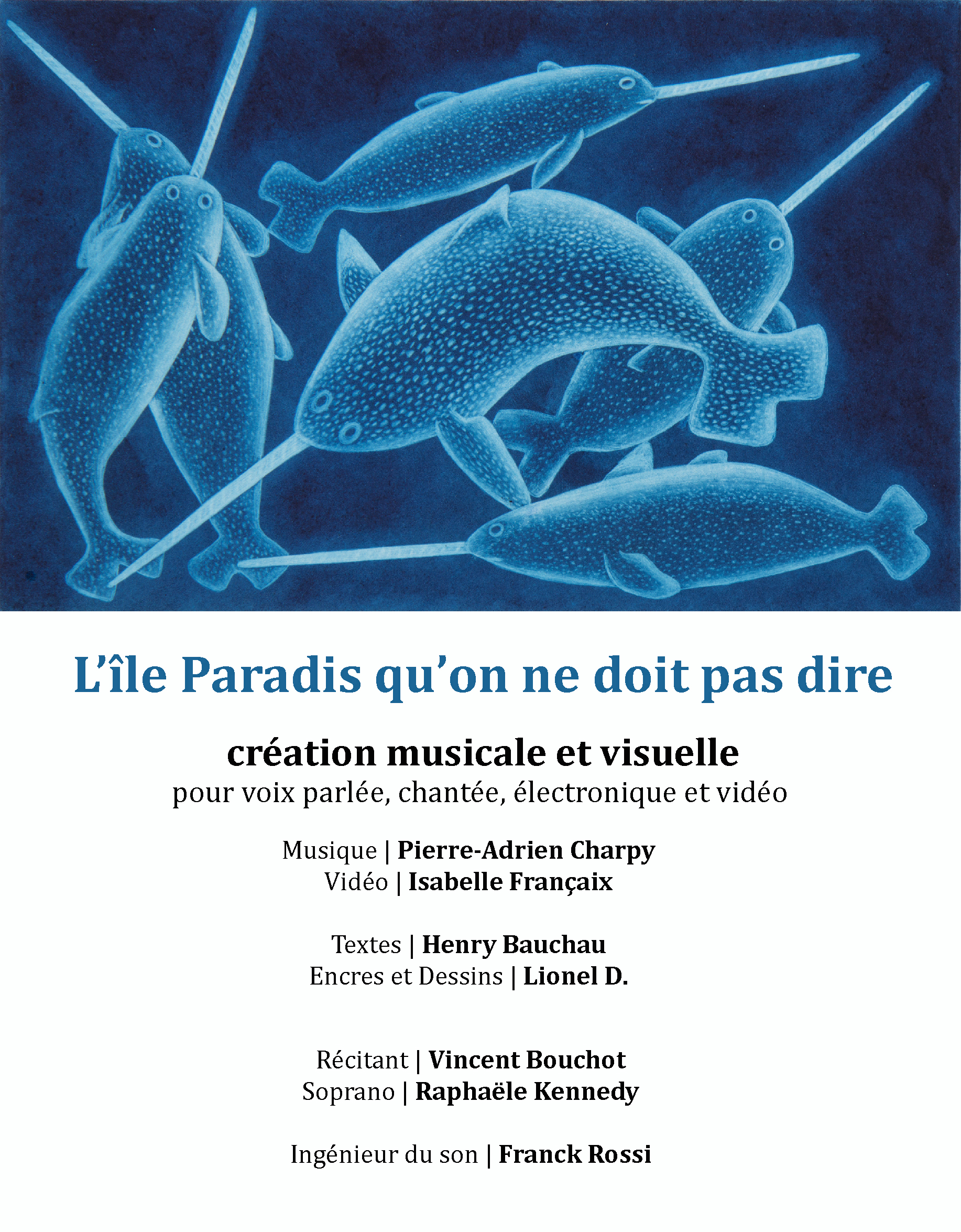
The writer Henry Bauchau (1913-2012) writes to himself and addresses his intimate reflections to his readers. From his letters and diaries written during the gestation and writing of the novel L’enfant bleu (Actes Sud, 2004) conceived on a true story, this show freely explores the correspondences between what we don’t know, live, dream or create when the daily life is torn apart. In the mysterious echo of images and sounds, the young psychotic Orion draws the labyrinths that will guide him towards creation in the day hospital with his « psychotherapist ».
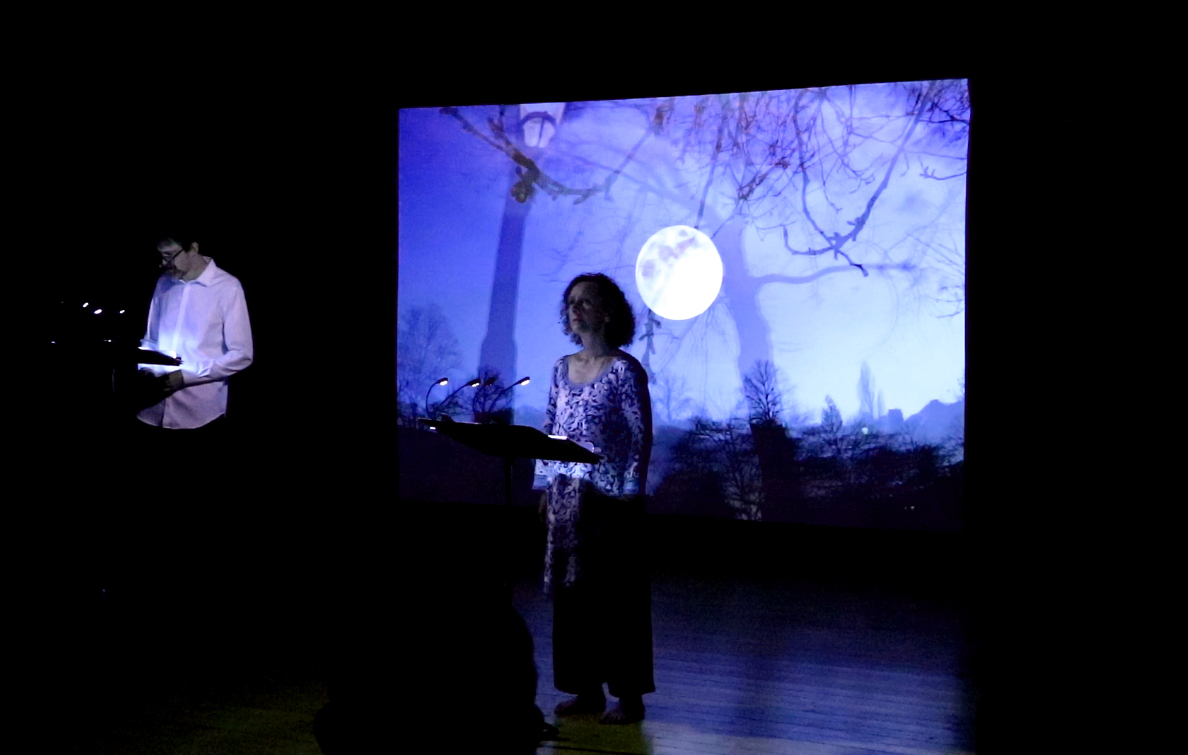
L’enfant bleu is indeed a text made to be read and perhaps one day put to music.
Henry Bauchau, Passage de la Bonne-Graine, 1999
Thank you for giving me – us – this unique moment. I am sure that Henry [Bauchau] was with you, with us, and that he would certainly have liked your Blue Child very much. […] One does not emerge unscathed from L’île Paradis that one should not say. […] To all, we were with you, with the other, with the living, with what in us, exceeds us and understands us. We were in the « body hymn », the one that animates us and carries us towards hope. […] We were lifted up. We descended in love and we experienced the most buried « in the island and the treasure ». We were faced with the abruptness of a nameless evidence.
Régis Lefort, writer and poet, specialist of Henry Bauchau, 2018[A] very high level show, very very strong, and very respectful and fair to the work of Henry Bauchau.
Thierry-Pierre Clément, poet, 2019The show […] puts in shape, at the price of a meticulous work, a labyrinth of sounds and images, colors and words, voices and songs… where each one can get lost according to his imagination. The music […] of Pierre-Adrien Charpy develops a rich sound world […]. It is omnipresent, but leaves a necessary place to the speech, to the mosaic narrative of the spoken and/or sung voices of Raphaële Kennedy and Vincent Bouchot. Their duet moves beyond the subject, by their powerful and accomplice presence, amplified by the phantasmagorical « setting in sound » of the ingenious engineer Franck Rossi. The show of « total art » is also worth by the poetry of the video creation of Isabelle Françaix and its moving images […].
Zibeline, Jacques Freschel, 2018
FILMS
LE MUR DE LA DAUPHINE
Documentary film by Alain Boeuf
Photography, sound recording, editing and realisation : Alain Boeuf | Original music and mixing : Pierre-Adrien Charpy | Production Mocco | Shooting equipment : Roland Cottet | Promotion and distribution : Alain Barlatier | Thanks : Ferial Khoury-Bec, Philippe, Ronéan, Gwénaël & Faustin Bec
A Da Pacem poduction
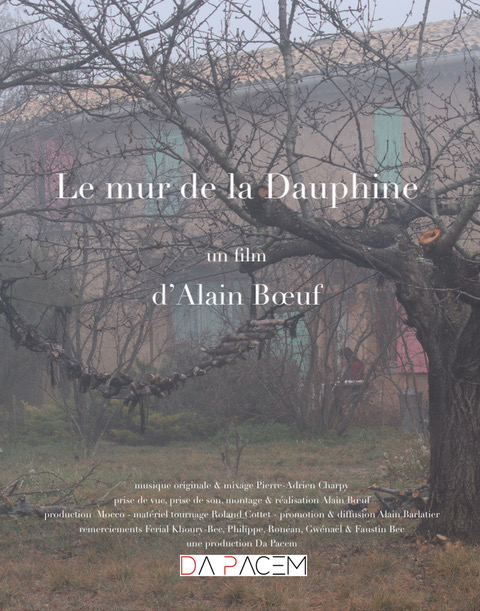
It’s now seventy years since Jean Bec laid down his arms, his weapons as a communist resistance fighter, on the Valensole plateau where he lived and where he fought the German invaders during the Second World War. Laid down? Perhaps. But surrendered? Hell no! « The Bolshevik-style revolution would come after the liberation – we’d have to be ready! » But things didn’t turn out that way. For two generations, this has been the story we tell each other by the fire in the evening. But ten years after his death, one enigma has still not been solved : where did he hide his weapons? Philippe, his grandson, has since returned to live in the mas de la Dauphine. He suspects that his grandfather hid his weapons in an adjoining building, in the old bread oven enclosed by a cinderblock and brick wall. Over the course of a weekend, he, his wife Ferial and their three children are determined to break down the wall that separates them from the historical truth, and thus perhaps put an end to a family legend. More broadly, it’s an opportunity to question the meaning of history, of belonging to a territory or a place, of the transmission of values from one generation to the next, of family heritage… More prosaically, everyone has the right to fantasise about what lies behind this wall. Treasure? The corpse of a German soldier? A painting by Picasso? The famous weapons? Nothing at all (which is what everyone secretly fears…)? This wall to be broken down quickly became a symbolic issue. Ferial’s dual Palestinian and German origins are marked by the building of a wall. This heritage collides with Jean Bec’s history. On her mother’s side, the Berlin Wall has become the historic symbol of a divided people. On her father’s side, the wall separating two antagonistic peoples, in a territory from which her family was expelled in 1948, then forced to take refuge in Jordan. As if locked out. For her, the Mas de la Dauphine is above all an opportunity to make a fresh start. It’s a question of reseeding the family and the environment, far removed from her parents’ conflict and the suffering of the farmers in Jean Bec’s day. Should we break down the walls to start a new story, « to transform a place of suffering into a place of pleasure », as she puts it? Or, as Gwenaël, one of her sons, thinks, should we leave untouched what doesn’t belong to us? The more the cinder blocks of the Dauphine wall crumble, the closer we come to solving the mystery, and the deeper we plunge into psychological introspection and doubt.
BLU-RAY
EKSTASIS
Kaija Saariaho & Jean-Baptiste Barrière
Aliisa Neige Barrière | Camilla Hoitenga | Raphaële Kennedy | Design and realisation of the images, electronics and final mixing, electronics realisation : Jean-Baptiste Barrière | Video processing : Pierre-Jean Bouyer et François Galard | Video shooting, editing and color grading : Isabelle Barrière | Technical conception and supervision : Image Auditive | Engineering, editing, vocal and instrumental sound mixing : David Lefeber / Metier Productions | Electronics realisation : Thomas Goepfer | Booklet notes : Didier Lamare | Translations : Paul Willenbrock | Digipack’s pictures and booklet’s cover : Jean-Baptiste Barrière | Booklet’s photographs : Isabelle Françaix | Graphic design : Luc Van de Velde | Interviews moderated by Pierre-Adrien Charpy, directed by Isabelle Françaix
Blu-Ray & CD box set AVECypres 02 / CYP2624
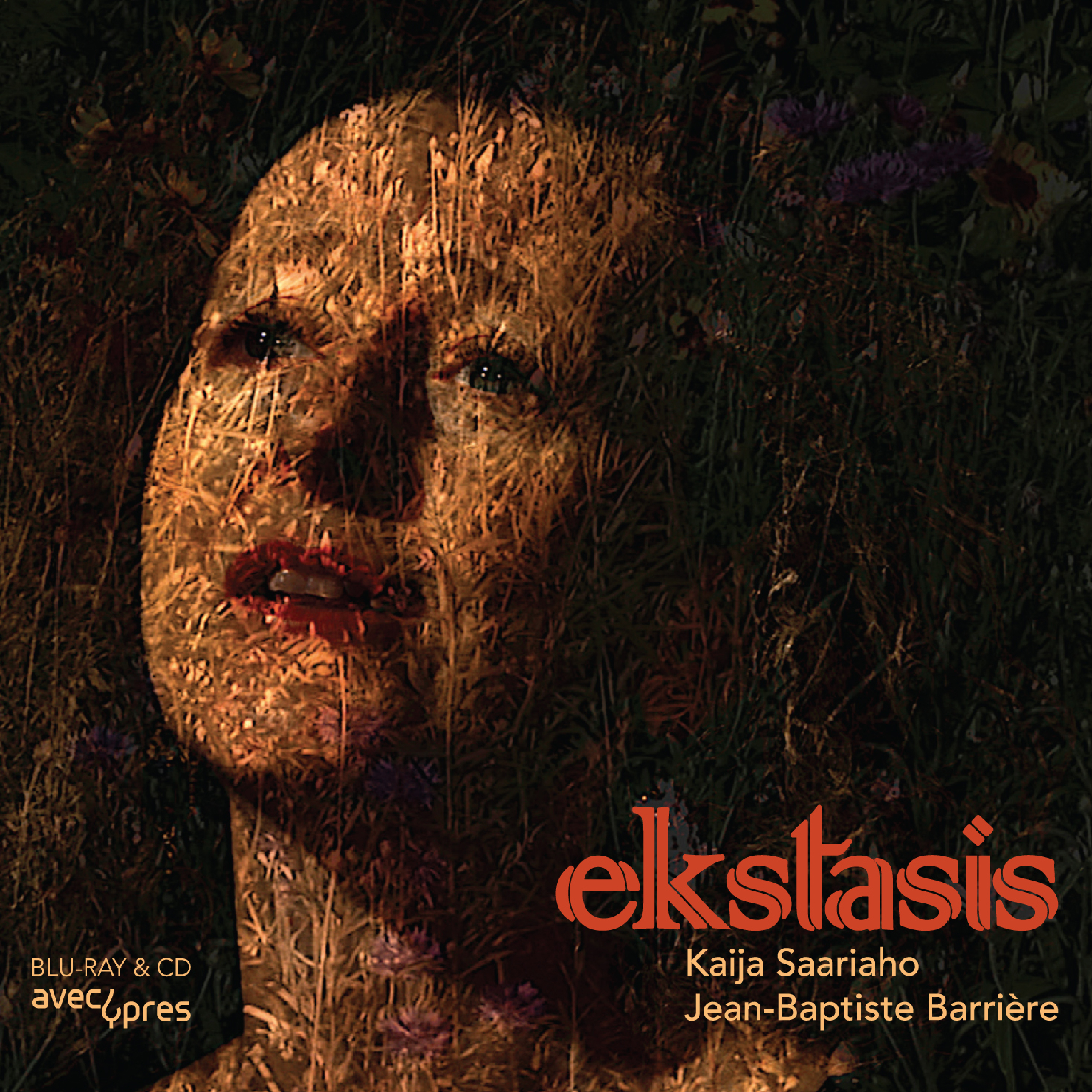
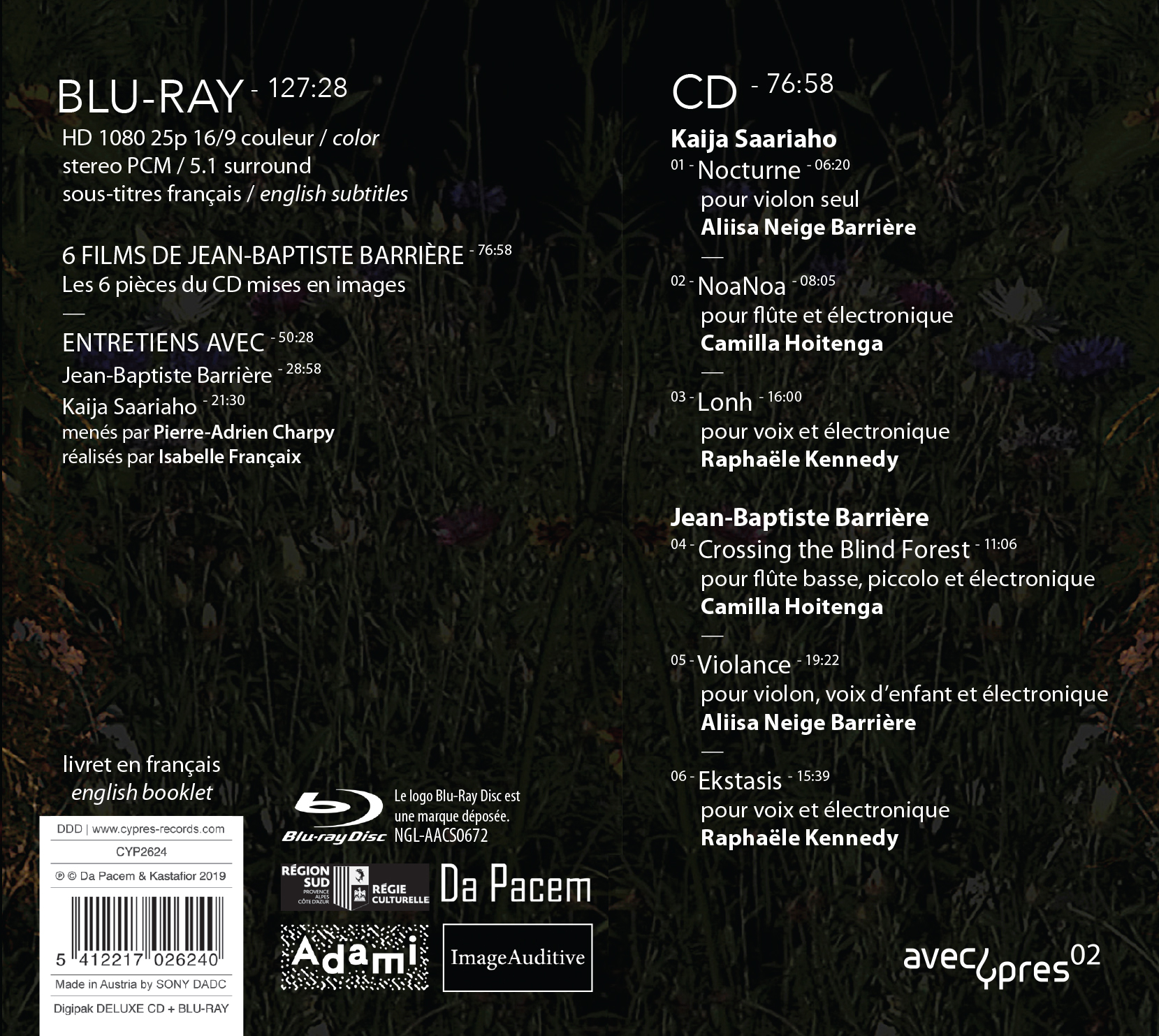
Sensory correspondences, displacement of the imagination, reversal of perspectives: it is to a similar experience that ekstasis invites you, a musical recording and multimedia object built by sound and image around six works by Kaija Saariaho and Jean-Baptiste Barrière. The complementarity of their creative paths, living together and often working in the same way, draws the quite precise organization of the work presented in this album. Prima la musica, dopo la visione… The three works of Kaija Saariaho are musical compositions, sound constructions, acoustic and electronic, pre-existing the vision of her husband. Jean-Baptiste Barrière’s three pieces were conceived as multimedia works, and first of all for the visual concert, with lines and rhythms that are perhaps more direct, leaving open spaces to receive the images. The object is both a premiere and, if not an assessment, at least a look at twenty years of multimedia work by Jean-Baptiste Barrière on music, and especially around the visual concert. Fixed for the first time on a high definition support, with a maniacal care given to the calibration, the editing, the breaths, the creation is freed from the vicissitudes of the stage to face other constraints.
Didier Lamare
An intoxicating Blu-Ray puts into sound images « six visual concerts » by the Finnish composer Kaija Saariaho and the French composer-video artist Jean-Baptiste Barrière.
L’Echo, Stéphane Renard, 2019Ekstasis box, a precious and unusual object.
A sensory journey that accompanies a music that is just as much.
Le soir, Gaëlle Moury, 2019[…] The three works by each composer have the same propensity for intimate confidence. Saariaho’s works (written in the 1990s) show an exceptional quality of deployment. Nocturne’s spidery weave, NoaNoa’s spatialized amplification and Lonh’s enchanting revolutions. More recent (2003-2014), those of Barrière (the twirling Crossing the Blind Forest, the bewitching Violance and the penetrating Ekstasis) reveal a taste for the projection of the vocal or instrumental gesture which, even before viewing the Blu-ray coupled with the CD (same program, with images), ensures that the musician doubles as an authentic director.
Le Monde, Pierre Gervasoni, 2019Three musicians are united here: flutist Camilla Hoitenga, faithful to the mazes of the two composers; violinist Aliisa Neige Barrière, their daughter, whose physical and musical presence diffuses a venomous enchantment; soprano Raphaële Kennedy, in a silver-tipped incarnation which, in our opinion, imposes the reference versions of the two vocal pieces.
L. L., 2019
Buy the physical box-set (Cypres records)
Buy the dematerialised form (vimeo AVECypres)
CD
SILLAGES
Pierre-Adrien Charpy
Raphaële Kennedy | Duo Anthony Leroy & Sandra Moubarak | Thomas Keck | Marylise Florid | Anaïs Gaudemard | Solistes XXI, direction Rachid Safir | Moussa Héma | DA PACEM : Sylvie Moquet, Yannick Varlet, Pierre-Adrien Charpy | Engineering, editing, sound mixing : David Lefeber / Metier Productions | Booklet notes : Didier Lamare | Translations : Paul Willenbrock | Photographs : Isabelle Françaix | Graphic design : Luc Van de Velde
2-CD box set AVECypres 01 / CYP2623
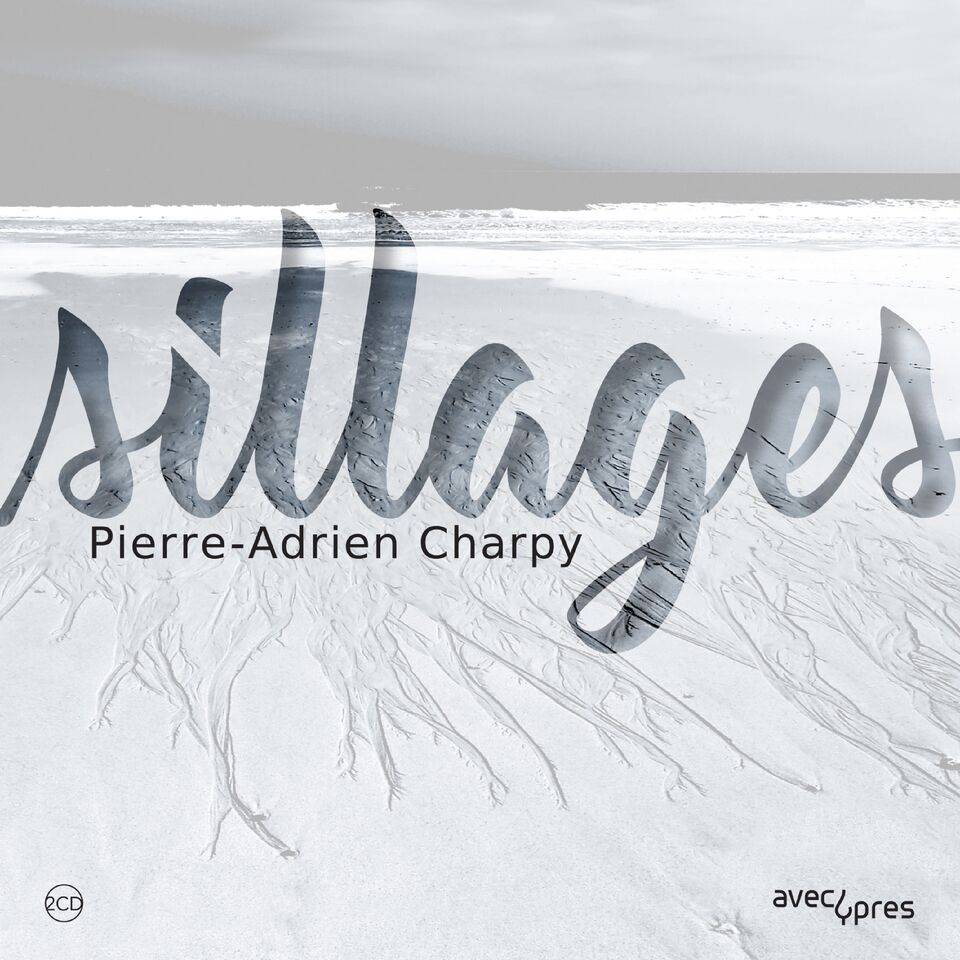
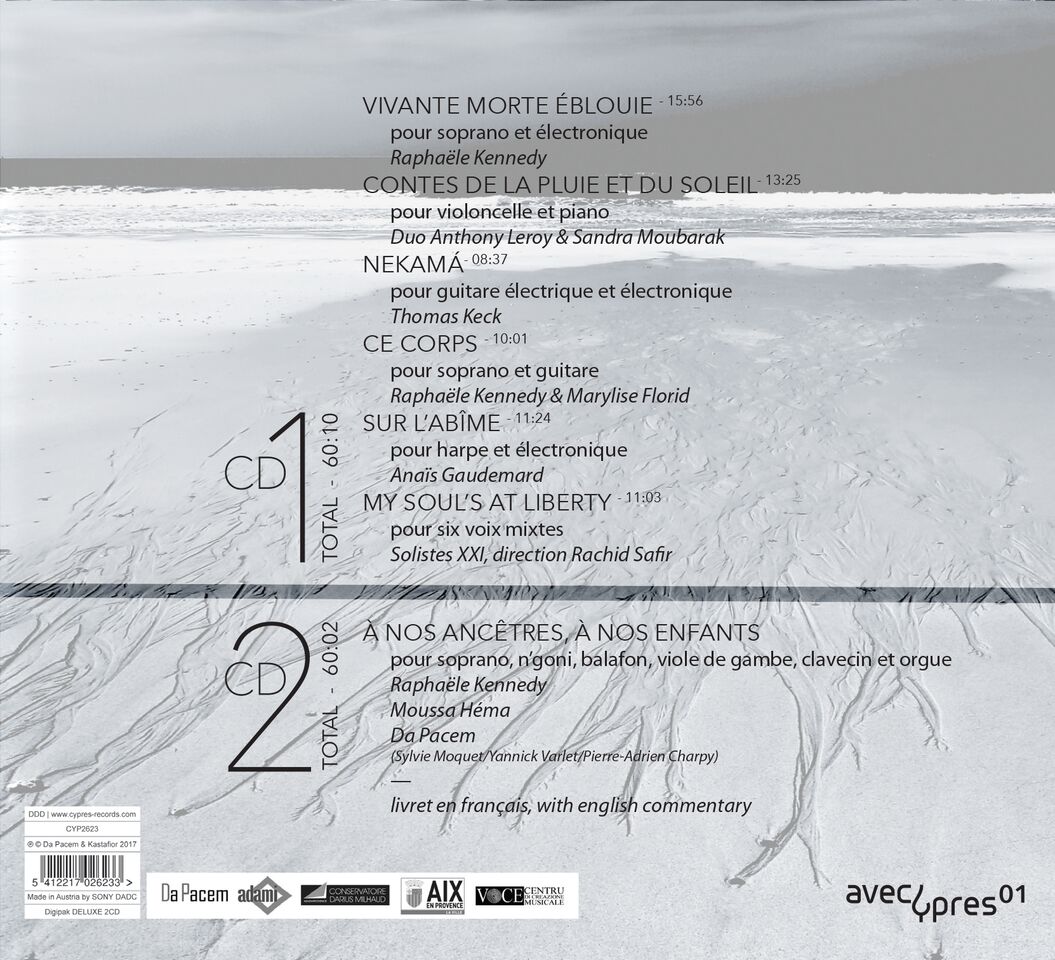
Some sorts of music can sound like delicate lithographs, others like large frescoes. The pieces presented in the first volume of this album belong to the composer’s collection of jewellery, his etchings, his small-scale works with the delicate wash of the watercolour or the precise impasto of the paintbrush. The second volume unfurls in one breath a concert-work which is nothing less than a panorama painted on fresh plaster, depicting an almost hallucinatory voyage in which the listener is invited to dance just as much as to meditate. This hour of music, a sequence of baroque, contemporary and traditional music, forms an innovative opening to the music of our time, into which some will venture who would otherwise never have dared.
Didier Lamare
His is an organic multifaceted music, through which run visible strata and unsuspected crevices, enlivened by surface currents and subterranean flows. […] His music is that of today, neither modern nor post-modern – often a music of the sea, always of open spaces, of zoom and of wide-angle, of sensations, of emotions. And his composition is free from the dogmas […].
Didier Lamare, 2017The album is a success on the visual level – signed Isabelle Françaix for the photos and Luc Van de Velde for the graphic design – and just as much on the literary level, thanks to the captivating (and not without humor) texts of Didier Lamare, who guides the reader through a program […] of exceptional richness and diversity. At the heart of the matter, the Frenchman Pierre-Adrien Charpy, […] prolific, imaginative and free composer, whose each work presented here is the fruit of a particular alliance and, therefore, of a particular inspiration. At the top of the list are those that unite him with his companion […] the soprano Raphaële Kennedy.
La Libre Culture, Martine D. Mergeay, 2017At the beginning, a long and sinuous melody for the voice of Raphaële Kennedy […]! It is the abandonment of the bodies that we hear, with the sensual breath of the soprano, the obstinacy of the rhythms, the suspension of the scintillating percussions, the backwash of the sea… […] vast sound world imagined, between 2001 and 2015, by a composer as much impossible to circumvent as talented […]! In « Sillages », we discover sound dialogues mixing traditional textures with electronics, invitations to travel to familiar and unheard-of places […]. Mixed pieces that reflect Pierre-Adrien Charpy’s openness to historical, geographical and stylistic worlds, full of sensuality, light, animated, powerful and voluptuous.
Zibeline, Jacques Freschel, 2017Pierre-Adrien Charpy, […] escaped from the chapels, [is] concentrated on the essential: to breathe, to feel, to transmit. From Marseilles, he is a solar and maritime musician. The photographs illustrating the boxed set bear witness to this universe of deep waters and iridescent lights that is easy to spot in most of his pieces. Intellectual, that is to say that knowledge is not a disgrace for him, sometimes mystical, he discreetly uses in his work the accumulated layers of Western culture […].
Lionel Lestang, 2017With the composer Pierre-Adrien Charpy, there is […] a whole memory of music that emerges […]: it is the very density of a rich sound layer nourished in depth by a past in the present of modernity.
Le blog-note de Benito on radio dialogue RCF, Benito Pelegrín, 2017
Buy the box-set (Cypres records)
DIETRICH BUXTEHUDE
Une alchimie musicale
Raphaële Kennedy | DA PACEM : Virginie Descharmes, Stéphanie Paulet, Sylvie Moquet, Marc Wolff, Yannick Varlet, Pierre-Adrien Charpy | Engineering, editing, sound mixing : Jean Gauthier
K617
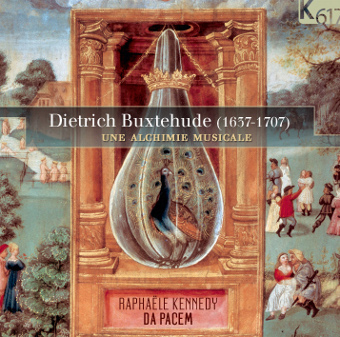
Who can resist the pleasure of exploring the universe of this wonderful composer? He was a true middleman between different musical styles and periods, who achieved a staggering synthesis of the polyphonic, numerical and rhetorical traditions of his predecessors with a very personal poetry, by building musical structures of hitherto unknown richness, all embellished with great tenderness, taking care to make his music accessible to everyone, from the specialist to the layman. It is not surprising that Bach took him as his model!
O dulcis Jesu (extract)
A perfect musical alchemy. […] The performers have not spared their talents, which are numerous. Raphaële Kennedy’s timbre, diaphanous and ethereal, knows how to embody herself in vibrant accents. […] This soprano has a deep sense of declamation which is marvelous here in this music which is permanently based on the text.
Utmisol, Hubert Stoecklin, 2011[…] The soprano Raphaële Kennedy is an exact accomplice of the Buxtehudian piety. […] [She] knows how to stimulate the power of words from within, both Latin and German motets. However, to the accuracy of her expressiveness is added virtuosity, not conquering and sure of its effects, but concerned with touching, rather than pleasing. This is the most fervent portrait of this outstanding creator […].
Classica, Roger Tellard, 2011Buxtehude transmuted. […] In these pieces, Raphaële Kennedy’s timbre and phrasing are marvelous: her sometimes ethereal voice and unaffected singing have just the right amount of human character to give sacred laments, with a final Klag-lied, in other words, a lamentation, which she unfolds with emotion like a painful litany that would never end.
Musikzen, Gérard Pangon, 2011In the service of superb opuses to be discovered, [the instrumentalists] create a subtle, intimate and poetic universe to support and dialogue with the very beautiful timbre of the soprano, suave, airy and perfectly controlled.
Zibeline, Frédéric Isoletta, 2011The CD tastefully combines religious cantatas for soprano and instrumental pieces. I listened to them with enthusiasm from the first bar to the last. This was the first time I had heard the soprano Raphaële Kennedy and I was immediately impressed by her clear, present voice, which sparkles in the high notes and displays its full brilliance while always being in tune with the Christian humility of these religious texts. The whole Da Pacem ensemble is as good as the soprano. « Da Pacem » means « give peace », and this is precisely what the musicians achieve: none play aggressively or put themselves forward, but no one hides either. Working together, they create a great musical density, in other words, they make music in a discreet, fine way, full of love and tension.
Radio Südwestrundfunk, Doris Blaich, 2011
ANDRÉ CAMPRA
Motets à une et deux voix
DA PACEM : Raphaële Kennedy, Claire Lefilliâtre, Virginie Descharmes, Pierre-Adrien Charpy | Engineering, editing, sound mixing : Franck Jaffrès
Arion
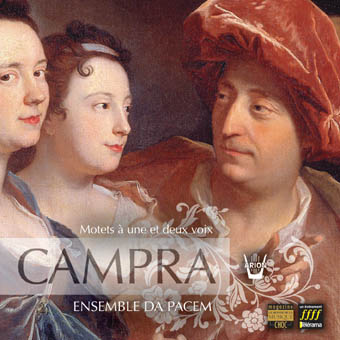
André Campra is a federator of French and Italian styles, even in his smallest motets. He is a man of jubilant vocalisations, subtle harmonies, colourful orchestration and refined melodies. In his Apologie de la musique française, Laugier summed up perfectly in 1754, the soul of this outstanding figure of the French 18th century: « Lalande is an artist who is held in higher esteem, Campra is a seducer who is infinitely loved ».
Stéphan Perreau
Salve Regina
The two young soloists […] compete with each other in grace and inspiration : the purity of vocal emission, the beauty of the vocalises, the expressive intensity and precision […].
Le Monde de la Musique, Philippe Venturini, 2000[…] the performers […] present this music with perfect taste…
Télérama, Xavier Lacavalerie, 2000Raphaële Kennedy joins up with the talents of Claire Lefilliâtre to create a real emotional whirlwind.
Classica, Coralie Welcomme, 2000Both singers have beautiful voices […]. Raphaële Kennedy’s tone is […] perfect, and her subtle use of vibrato adds a bit of spice to the music, without getting in its way.
Classical Music Web, Kirk McElhearn
NICOLAS BERNIER
Leçons de Ténèbres du Premier Jour
DA PACEM : Raphaële Kennedy, Emmanuel Jacques, Pierre-Adrien Charpy, Hélène Decarpignies, Edwige Parat, Karine Sérafin | Engineering, editing, sound mixing : Jean Gauthier
Champeaux
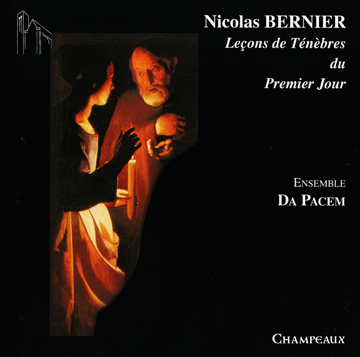
Nicolas Bernier is incontestably one of the most remarkable figures in French music at the beginning of the 18th century. His Tenebrae Lessons hold a special place in his output : apart from the fact that none of them were published, they are the expression of a typically french art from the pen of a deliberately italianist composer.
1ère leçon de Ténèbres du premier jour (extract)
The performance of the Leçons deserves nothing but the highest of praise. Raphaële Kennedy’s voice is solid, supple, attentive to the least inflexion of the musical text, and in perfect complicity with the continuo. Her timbre is at once clear, homogenous and warm.
Répertoire, Michel Lamalle, 1998Raphaële Kennedy’s sweet, clear voice is full of grace and delicacy. […] Everything contributes to an atmosphere of ecstasy
Classica, Stéphan Perreau, 1998The devotional character revealed by soprano Raphaële Kennedy is prodigious in its simplicity : without artifice and with total disregard of herself, she communicates suffering, sadness and doubt with these « musical lamentations » which touch the heart and truly reach the mark. […] An exaltation that intoxicates and delights<
Crescendo, Noël Godts, 1998Raphaële Kennedy shows herself to be completely at home in this music, and faultless in her precision […].
Diapason, Jean-luc Macia, 1998
Photos credits:
Pélagos©Sandrine Ruitton
L’île Paradis qu’on ne doit pas dire©Isabelle Françaix
Le mur de la Dauphine©Alain Boeuf
Ekstasis©Jean-Baptiste Barrière
Sillages©Isabelle Françaix
